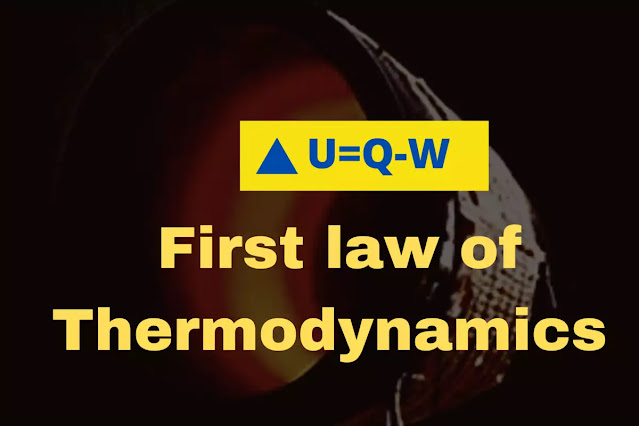The First Law of Thermodynamics
Hello mechons, in this post we are going to explain to you about a law of thermodynamics called First law of Thermodynamics with derivations, definitions and also the example of first of Thermodynamics.
Before going to learn about the First law of Thermodynamics, make sure that you know about Thermodynamic zeroth law.
If not read our Article titled "Zeroth law of Thermodynamics" to know about the thermodynamics zeroth law.
What is the First Law of Thermodynamics in a closed system?
When a system undergoes a thermodynamic cycle then the net heat supplied to the system from the surroundings is equal to a net work done by the system on its surroundings.
Q = W+∆E
If Q is the amount of heat transferred to the system and W is the amount of work transferred from the system during the process the net energy transfer (Q-W) will be stored in the system. The energy in storage is neither heat nor work and is names as internal energy or simply, the energy of the system.
We can write,
Q -W = ∆E
Here Q, W, and ∆E are units in joules. Energy stored in the system in different modes.
A differential form of The First Law of Thermodynamics is given by
δQ = δW + dE
δ- is Exact differential (Independent of Path)
E= K.E + P.E. + I.E
E = mV2/2 + mgz + U
δQ = δW + d( mV2/2) + d(mgz) + dU
Many thermodynamic process, changes K.E. and P.E. are negligible as compare to changes in I.E.
δQ = δW + dU
Different forms of stored energy
The energy in a storage called internal energy is a point or state function and hence a property of a system. The symbol E denotes the total energy stored in a system. Basically, there are two modes in which energy may store in a system,
The macroscopic energy mode consists of the macroscopic kinetic energy and potential energy of a system.
Ek = mV2/2
The microscopic energy mode refers to the energy stored in the molecular and atomic structure of the system, which is called the molecular internal energy. It is referred to as U.
One molecular energy contains the following energies:
- Translation energy
- Rotational energy
- Vibrational energy
- Nuclear binding energy
- Electron energy
Enthalpy:
The enthalpy of a substance, h, is defined as
Enthalpy is an intensive property of a system (kJ/kg).
Internal energy change is equal to the heat transferred in a constant volume process involving no work other than pdv work
δQ = pdv + du
At constant pressure,
where h = u+pv is the enthalpy, a property of the system. Heat transferred at constant pressure increases the enthalpy of a system.
For an ideal gas, the enthalpy becomes,
h = u+RT
The Internal energy of an ideal gas depends only on the temperature, the enthalpy of an ideal gas also depends on the temperature only,
h= f(T)
H=mh
The Energy of an isolated System:
An isolated system is one in which there is no interaction of the system with the surroundings. For an isolated system δQ = 0, δW = 0
Then first law becomes,
dE = 0
E = Constant
Therefore, the energy of an isolated system is always constant.
Perpetual Motion Machine of the First Kind-PMM 1
The first law tells us the general principle of the conservation of energy. According to the law of conservation of energy tells us energy is neither created nor destroyed but it can be transformed from one form to another.
There is no machine that would continuously supply mechanical work without some other form of energy disappearing simultaneously. Such a fictitious machine is called a perpetual motion machine of the first kind, or in brief PMM1. PMM1 is impossible.
There can be no machine that would continuously consume work without some other form of energy appearing simultaneously.
Conclusion
That's all about the first law of Thermodynamics, definitions, derivations, and examples of the first law of Thermodynamics.
I hope that you understand the definitions and examples.
If you have any queries or doubts or need improvements in this article put that in the below-mentioned comments section we will reply and rectify as fast as possible.

